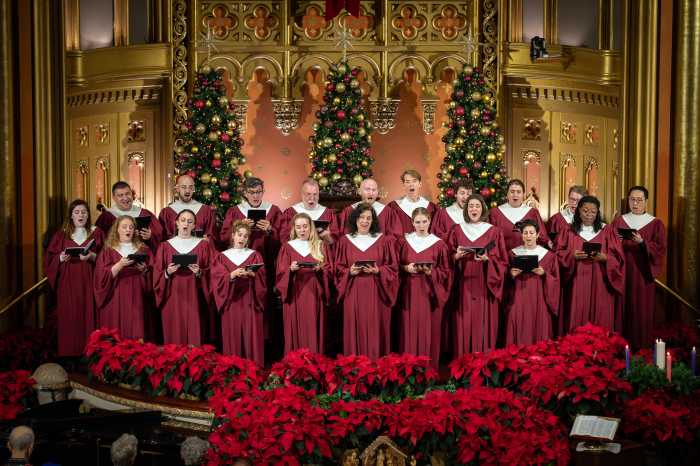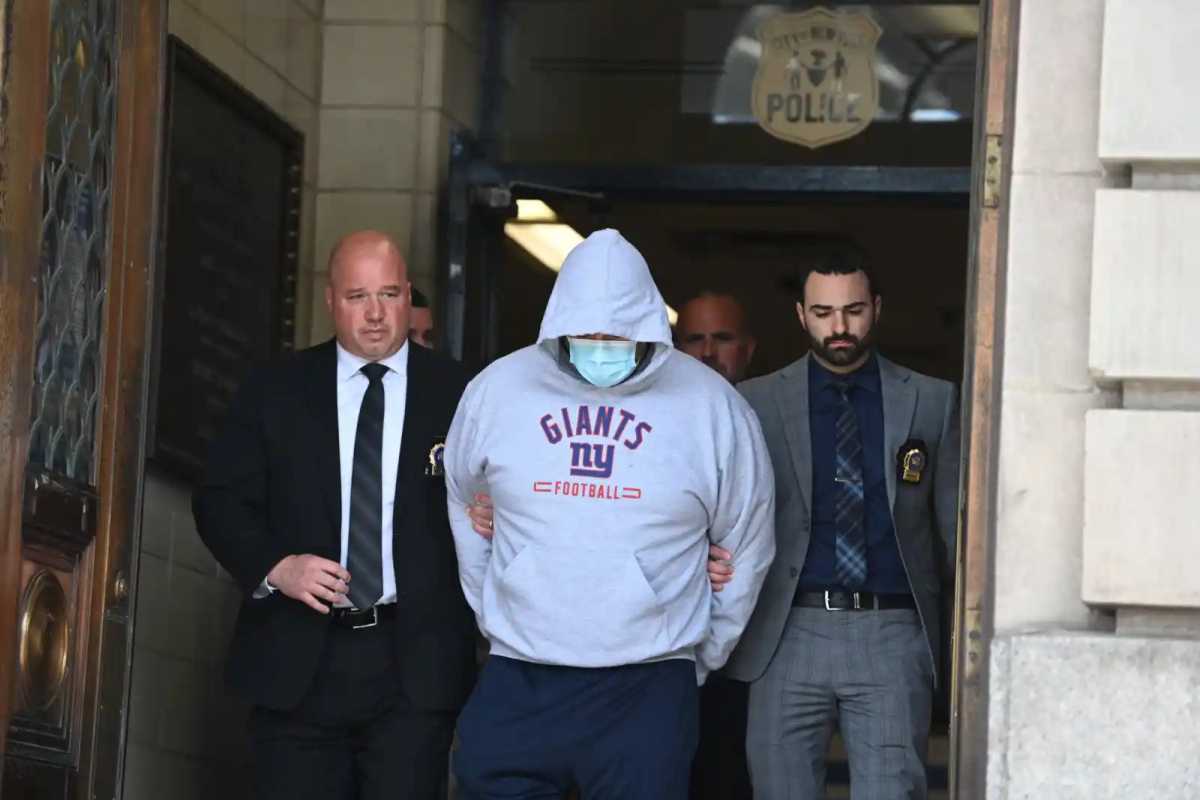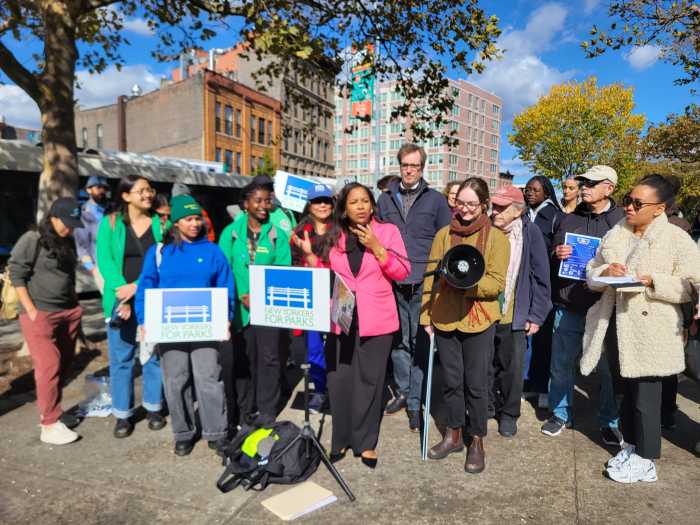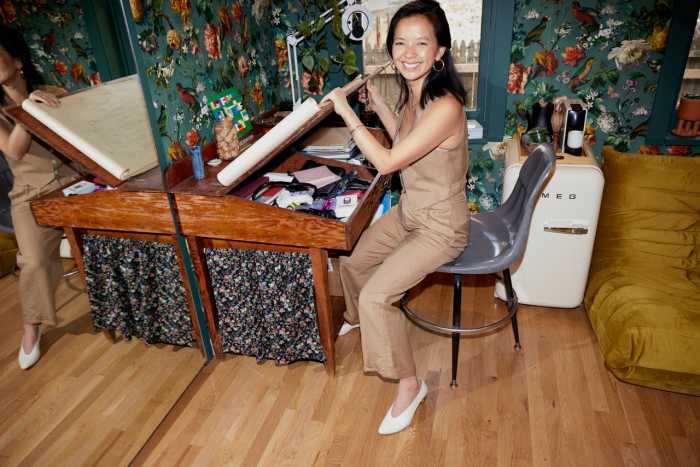By Lincoln Anderson
It’s known as the community-use facility zoning bonus — but the community, both east and west, is in an uprising over it. Two particular projects drawing residents’ wrath are an eight-story building under construction at 159 Bleecker St., on the former site of the Circle in the Square theater, and a new 13-story building underway at 81 E. Third St., next to the Hell’s Angels clubhouse.
In August, Andrew Berman, executive director of the Greenwich Village Society for Historic Preservation, communicated with the architect of 159 Bleecker St. At that time, Berman said, he was told plans were to include commercial space — possibly a bookstore or coffee shop — on the ground floor and two floors of community facility space for a university, topped by non-university apartments above.
Plans for the E. Third St. building call for six stories for dormitory use by a local university topped by seven stories of residential apartments.
In each case, the new buildings’ height is a concern. On E. Third St., the surrounding buildings are no more than six stories tall. On Bleecker St., many of the neighboring walkup buildings are two or three stories tall, though there are some bigger ones, like the Atrium apartments and hotel across the street from the site, and other equally large buildings along Bleecker St. between Thompson St. and LaGuardia Pl.
“We have been monitoring the site for two years, ever since the theater was empty,” said Berman. The site is part of the South Village area that G.V.S.H.P. wants the city to designate as a new landmarked historic district.
When they discovered plans called for an eight-story building, “a red flag went up for us,” Berman said, “because eight stories would require community facilities zoning. It’s out of scale and out of character with this neighborhood.”
Of special concern, Berman said, is the trend in which the new student residences are being done by private developers, not universities, as witnessed in the new New York University residence built a few years ago on the Bowery at E. Second St.
Susan Stetzer, district manager of Community Board 3, said initial plans for the E. Third St. building called for a six-story building with medical offices on the ground floor.
“All of a sudden, it changed to 13 stories — six floors of which are dorms,” she said. “This is a new concern that’s coming before the community board — buildings that don’t fit in the neighborhood because they’re too tall. We’re losing the ability to protect the character of the neighborhood.”
As the project plans were morphing confusingly, Richard Kusack, a neighbor with a knowledge of building matters, contended there was no way the E. Third St. developers could achieve a 13-story height using the community facilities bonus. However, Jennifer Givner, a Department of Buildings spokesperson, said that in response to The Villager’s inquiry, a D.O.B. expert reviewed the building plans and everything, indeed, is regulation as to the height and bulk. She said the ownership had changed up to twice, which caused some confusion.
Yet, Stetzer said Board 3 raised another issue — that 81 E. Third St. was being built without a lease in place for the community facility space. This time, the complaint was on target. Givner said that, in fact, a lease is required and that D.O.B. has issued the developer of 81 E. Third St. a “10-day letter.” The developer must remedy the situation — have a signed lease in place for a university tenant or other community facility use — within 10 days or risk having the Buildings permit pulled.
“We’re in that window right now,” Givner said, however adding that the developer could be granted a 30-day extension in which to cure the problem.
Givner added that, under a change in regulations, faculty housing cannot be the primary use of a community facility space. This new rule could have a bearing on N.Y.U.’s development of its Morton Williams supermarket site at LaGuardia Pl. and Bleecker St., where faculty housing has been among ideas rumored in the works.
As for 159 Bleecker St., Givner said a check of the plans, filed last week, show no community facility use. Floors one and two are slated for retail and professional use, the third floor as offices and four through eight for residential apartments.
Told of the Bleecker building’s new composition, Berman said, “That is great news,” adding that G.V.S.H.P. had written the owner and developer letters asking them not to include community facility uses.
“Whether we convinced them or scared them off — I have no idea,” Berman said. “It’s really the community facility bulk we care about, not the use.”
Community ire over community facilities buildings — and several other too-large projects in the East Village — has risen so high that Laura Osorio, Department of Buildings Manhattan borough commissioner, felt compelled to attend last Wednesday’s C.B. 3 Housing Committee meeting to address residents’ and the board’s concerns.
However, East Side and West Side, the community is starting to take matters into its own hands. Local universities are being asked not to be tenants in the community facility space.
G.V.S.H.P. reached out to N.Y.U., asking it not to rent space in 159 Bleecker St. In an e-mail in August to Michael Haberman, N.Y.U. director of government and community relations, Berman wrote: “My understanding is the developer is going to be seeking ‘one of the local colleges’ as a tenant (of which N.Y.U. is far and away the biggest), so if he hasn’t approached you guys yet I assume he will. As N.Y.U. is a supporter of the Historic South Village preservation effort, I would strongly urge the university not to support a development that would have a negative impact upon the historic integrity of this area, especially as it is the community facility bulk bonus, which will make this structure so out of scale with its surroundings. Is N.Y.U. willing to make a commitment that it won’t be exploiting the added bulk in this development? Or, even better, if I provided you with contact info, would you be willing to reach out to the developer to let them know that N.Y.U. will not be interested in the community facility space in this building? As I think they anticipate that you, or another local institution, will be interested, such a communication from N.Y.U. might help discourage them from ultimately including the extra community facility bulk in their plan.”
In response to Berman’s asking N.Y.U. for a commitment not to exploit the new Bleecker St. building’s then-anticipated added bulk under the community facilities bonus, Haberman at the time told The Villager: “We are not going to comment on a real estate project that we know nothing about.” Speaking Monday, he said he would let that statement stand.
On the larger issue of the zoning provision, Haberman said: “Community facility zoning recognizes the important role that nonprofit institutions play in New York City and the reality that they have special infrastructure needs for things like laboratories, operating rooms and theaters. The framers of the 1961 zoning resolution were prescient in realizing that nonprofit institutions would play an extremely important role in New York City (six of the city’s 10 largest employers are nonprofits) and that the city has to allow for them to grow in an efficient and cost-effective manner. Community facility zoning reduces the need for nonprofits to build multiple buildings across numerous sites, which minimizes the impact on neighborhoods….
“In relation to Greenwich Village,” Haberman continued, “contrary to popular myth, community facilities built by N.Y.U. in recent years are NOT bulkier or larger than many of the surrounding buildings. In fact, many of the buildings surrounding Washington Sq. Park, which date back to the 1800s, have a floor-to-area ratio that exceeds the F.A.R. permitted under the current community facility zoning.”
Meanwhile, at its September board meeting, Community Board 3 passed a resolution asking that none of the neighborhood educational institutions sign a lease to house students in a dormitory at 81 E. Third St.
In addition, Board 3’s chairperson, David McWater, and Housing Committee chairperson, Sam Wilkenfeld, on Oct. 7 sent a letter to John Sexton, N.Y.U.’s president, and Bob Kerry, New School University’s president, asking them not to lease the community facility space in the new E. Third St. building:
“Community Board 3 is concerned about maintaining the character of our neighborhood,” McWater and Wilkenfeld said. “This has become very difficult with developers exploiting the community-use facility bonus and building dormitories on side streets that until now have been completely populated by small residential buildings.
“….While there are objections to the dormitories on avenues, those on residential side streets have an even greater negative impact and do even greater damage to the character of the community.”
Asked if New School would abide by C.B. 3’s wishes regarding the Third St. project, Gloria Gottschalk, a university spokesperson, said, “I’m just told we’re not involved in any way.”
John Beckman, N.Y.U.’s spokesperson, said, “N.Y.U. is unaware of the project and uninvolved in it. Beyond that, I will say two things: first, that this kind of demand of N.Y.U. is not reasonable, unless the same request is being made of every not-for-profit in the city, any one of which could avail itself of the community facility calculation if it were involved; and second, we are simply not going to engage in a conversation about hypotheticals when we have a track record of dealing with realities — when N.Y.U. involves itself in a project, it lets the community know.”
C.B. 3 District Manager Stetzer said East Villagers have also complained about a few other buildings they consider too large, including the new, taller Ninth Precinct stationhouse being erected on E. Fifth St., a project on Second St. and another on St. Mark’s Pl. A new combination residential building/boutique hotel going up on a former gas station at E. Third St. and Bowery is also drawing fire for reportedly not being constructed according to original plans. Stetzer said the developer also was slow to submit an affidavit vouching gas tanks had been removed from the ground, though eventually did submit it.
Harvey Epstein, former chairperson of Board 3 and of its Housing Committee, said Buildings is not policing violators, and that nothing is done after buildings aren’t built to specification or loopholes are abused. He specifically pointed to the new building at Bowery and E. Third, noting that neighbors had been complaining about it since July, but Buildings let the job proceed, and that what was built — for example the street wall on the Bowery — doesn’t conform to zoning or original plans.
“I think there is a really big issue of these bogus dorms and hotels,” Epstein said. “That’s what we’re going to face now…. Even when we’re right, what’s the chance of a court telling them to take the building down?” In fact, this only happened once in New York City in recent memory, Epstein said, on the Upper West Side about 20 years ago.
Added McWater, “The big fear is an end run — condo it or market-rate it and then say, ‘What are you gonna do, sue me?’ Are they going to tell them to take it down?”
However, Berman said there is hope for change, noting that at Mayor Bloomberg’s town hall meeting in the Village in August, Commissioner Amanda Burden of the City Planning Commission said she’d be willing to work with the community and G.V.S.H.P. on ways to reduce the size and bulk allowed under community facilities zoning.
Also Read: https://www.amny.com/news/n-y-u-gets-21-million-endowment/







































